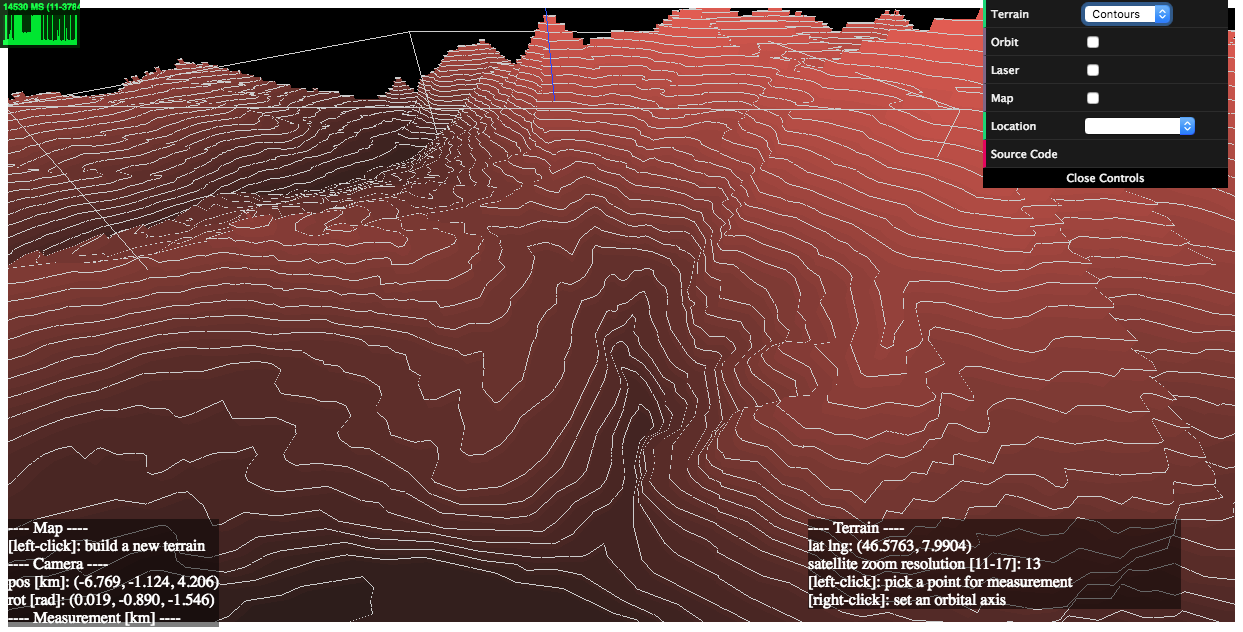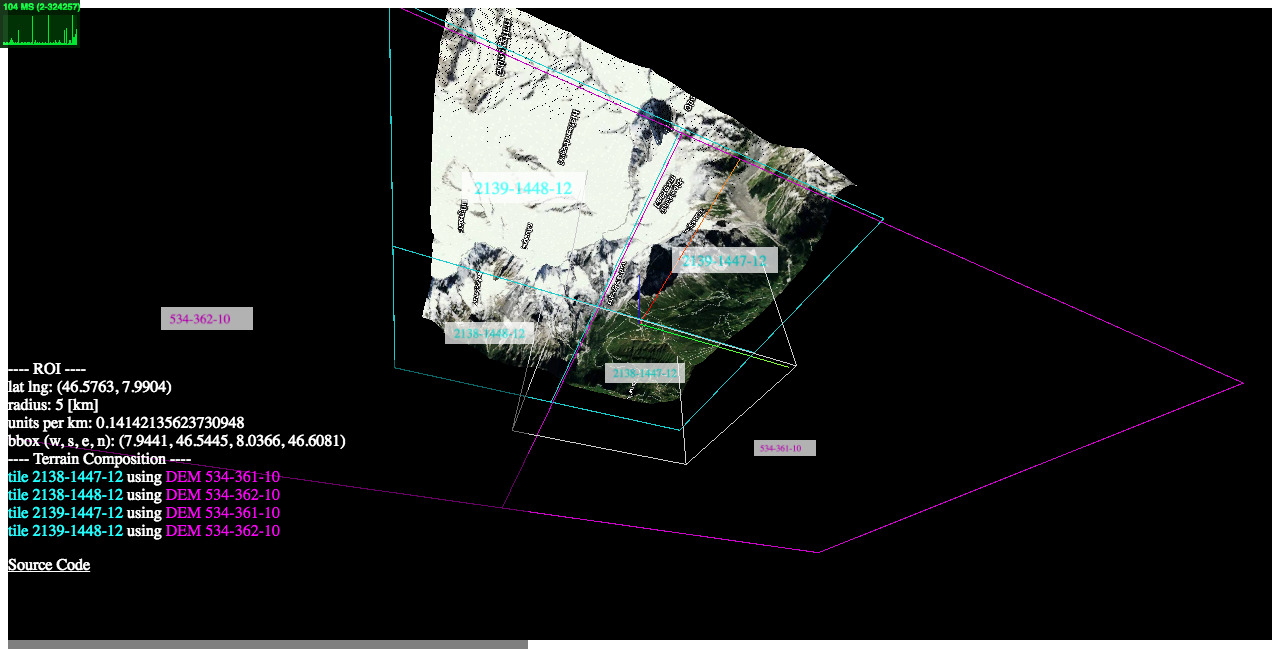three-geo is a three.js based geographic visualization library. Using three-geo, we can easily build satellite-textured 3D terrain models in near real-time by simply specifying GPS coordinates anywhere on the globe. The geometry of the terrain is based on the RGB-encoded DEM (Digital Elevation Model) provided by the Mapbox Maps API.
The terrain is represented by standard THREE.Mesh objects. This makes it easy for us to access underlying geometry/texture array and perform original GIS (Geographic Information System) experiments in JavaScript. (See Usage for how to programatically obtain those mesh objects).
Credits: this library has been made possible thanks to
- geo-related libraries such as mapbox, Turfjs, d3 in npm, and the Mapbox Maps API.
- peterqliu for informative 3D terrain-related articles and implementation.
1) examples/geo-viewer (live | source code).
This demo app includes features such as
- on-demand 3D terrain building (by a mouse click on the Leaflet map),
- real-time camera projection onto Leaflet (with oritentaion and HFoV indication),
- terrain interaction with a VR-like laser beam,
- measuring Euclidean distances between terrain points,
- auto camera orbiting around the custom z-axis.
Live:
https://w3reality.github.io/three-geo/examples/geo-viewer/io/index.html?lat=46.5763&lng=7.9904
-
https://w3reality.github.io/three-geo/examples/geo-viewer/io/index.html?lat=36.2058&lng=-112.4413
2) examples/heightmaps (live | source code).
This demo illustrates the relationship between a reconstructed 3D terrain and its underlying satellite/DEM tiles.
Installation
$ npm install three-geo
Loading
Via script tags: use ThreeGeo after
<script src="three.min.js"></script> <script src="dist/three-geo.min.js"></script>
Via the ES6 module system: use ThreeGeo after
import ThreeGeo from 'three-geo/src';
Here is an example of how to build a geographic terrain located at GPS coordinates (46.5763, 7.9904) in a 5 km radius circle. The terrain's satellite zoom resolution is set to 12. (The highest zoom value supported is 17.)
For standalone tests, use examples/simple-viewer (source code).
const tgeo = new ThreeGeo({
tokenMapbox: '********', // <---- set your Mapbox API token here
});
// params: [lat, lng], terrain's radius (km), satellite zoom resolution, callbacks
// Beware the value of radius; for zoom 12, radius > 5.0 (km) could trigger huge number of tile API calls!!
tgeo.getTerrain([46.5763, 7.9904], 5.0, 12, {
onRgbDem: (meshes) => { // your implementation when the terrain's geometry is obtained
meshes.forEach((mesh) => { scene.add(mesh); });
render(); // now render scene after dem meshes are added
},
onSatelliteMat: (mesh) => { // your implementation when terrain's satellite texture is obtained
render(); // now render scene after dem material (satellite texture) is applied
},
});- jet-wasp - Three-geo as A-Frame component (source code)
- Your App - PR us!
ThreeGeo
constructor(opts={})
Create a ThreeGeo instance with parameters.
opts.tokenMapbox="" string Mapbox API token. This must be provided.opts.unitsSide=1.0 number The side length of the square that fits the terrain in WebGL space.
getTerrain(latlng, radius, zoom, callbacks={})
latlngArray<number> GPS coordinates of the form: [latitude, longitude].radiusnumber The radius of the circle that fits the terrain.zoomnumber (integer) Satellite zoom resolution of the tiles in the terrain. Select from {11, 12, 13, 14, 15, 16, 17}, where 17 is the highest value supported. For a fixed radius, higher zoom resolution results in more tileset API calls.callbacks.onRgbDemfunction (meshes) {} Implement this to request the geometry of the terrain. Called when the entire terrain's geometry is obtained.meshesArray<THREE.Mesh> All the meshes belonging to the terrain.
callbacks.onSatelliteMatfunction (mesh) {} Implement this to request the satellite textures of the terrain. Called when the satellite texture of each mesh belonging to the terrain is obtained.meshTHREE.Mesh One of the meshes that's part of the terrain.
callbacks.onVectorDemfunction (objs) {} Implement this to request the contour map of the terrain. Called when the contour map of the terrain is obtained.objsArray<THREE.Object3D> Extruded meshes (THREE.Mesh objects with .name attribute prefixed by dem-vec-shade-<ele>-) and lines (THREE.Line objects with .name attribute prefixed by dem-vec-line-<ele>-), where <ele> is the height of each contour in meters.
$ npm install # set up build tools $ npm run build # generate module files in lib/




